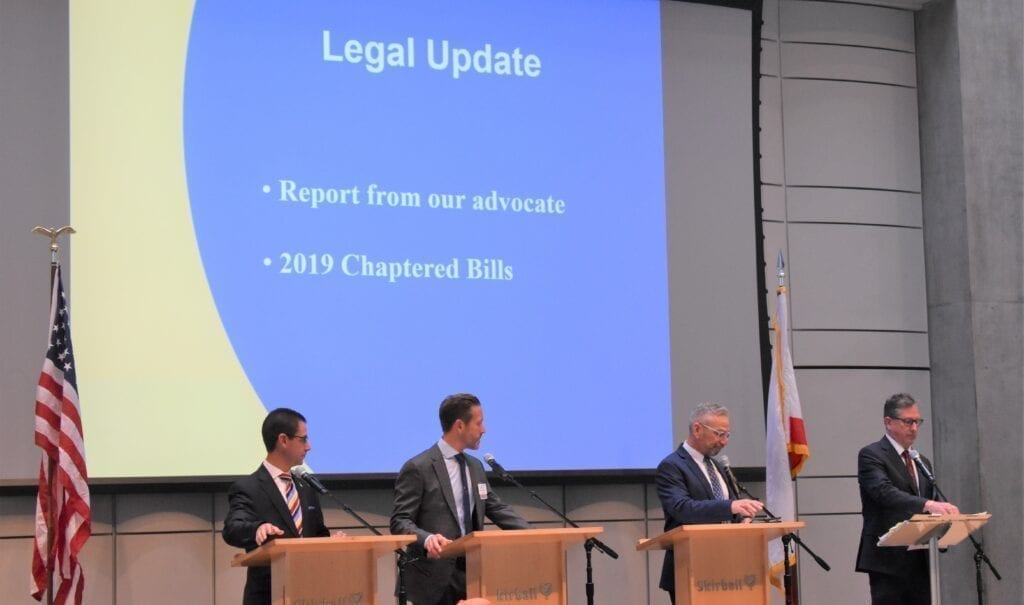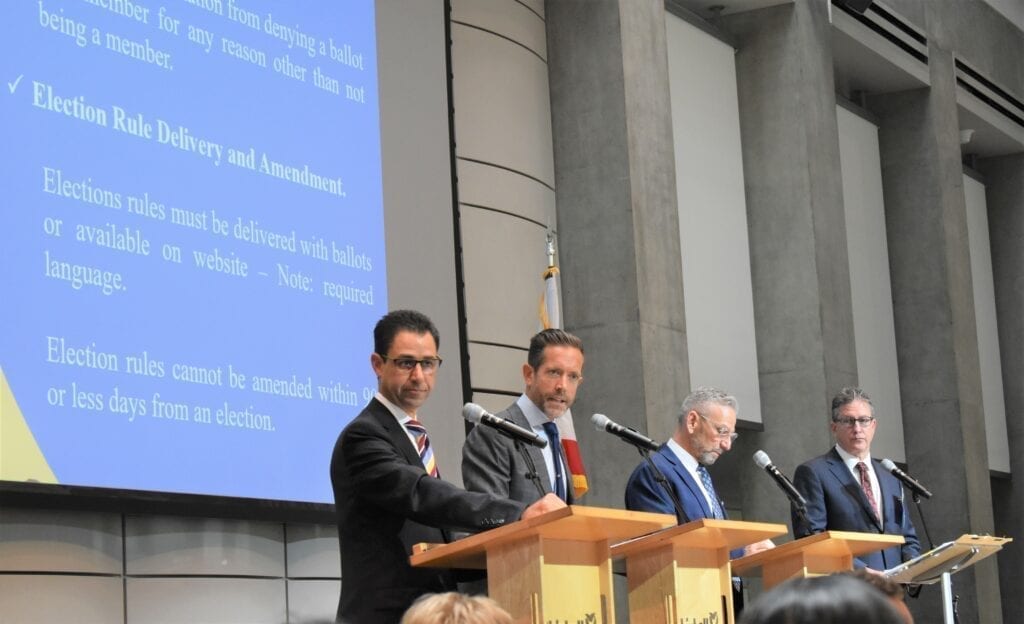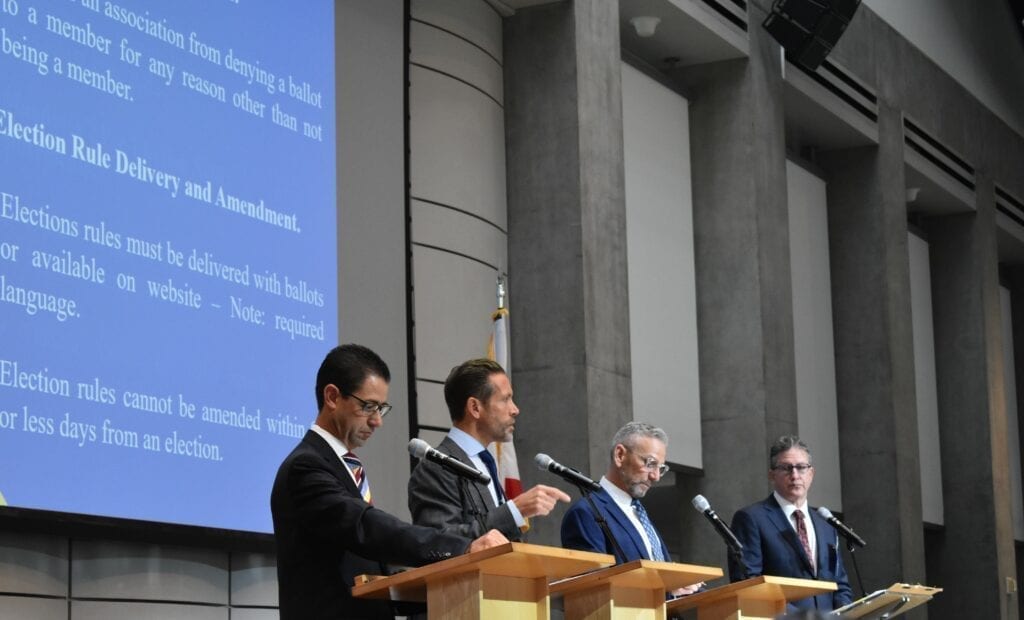Search Posts
Recent Posts
- Do you meet the definition of an “Accredited Investor” under the new SEC Rules? December 8, 2020
- Do You Really Have Time To Read & Understand The Heroes Act? November 23, 2020
- Governor Newsom – Please Order all Court Buildings in the State of California Closed starting March 16 March 15, 2020
- Three Men Arrested in $722 Million Cryptocurrency Fraud Scheme Targeting “Dumb” Investors December 10, 2019
- Should Court Transcripts be Provided to Parties Free of Charge? December 3, 2019
Categories
Subscribe!
Thanks for subscribing! Please check your email for further instructions.

I attended the CAI-GLAC’s Legal Update 2019 and Learned a Lot about the Impact of New Legislation
I serve as Treasurer of the Marina City Club Condominium Owners Association and requested our Management Company, Seabreeze Management, to sign me up for the CAI-GLAC’s Legal Update 2019. The speakers were awesome, lunch was delicious and people were friendly.

According to the Community Associations Institute (CAI), about six out of 10 new homes are built in a community association, and in 2019, approximately 25 percent of the U.S. housing market consisted of homeowners associations, condominium communities, and housing cooperatives.
The speaker lineup consisted of:
- Jeffrey A. Beaumont, Esq., CCAL, Beaumont Tashjian
- Matt D. Ober, Esq., CCAL, Richardson, Ober, DeNichilo, LLP
- Thomas W. Ware II, Esq., Kulik, Gottesman Siegel & Ware, LLP
- Louie Brown, Esq., CAI GLAC Legislative Advocate, Managing Partner, Kahn, Soares & Conway LLP
There is a lot of uncertainty with how the new legislation will play out. There are 13,000,000 Californians that live in 3,700,000 homes in more than 48,000 community associations. These residents pay $22 billion per year to maintain their communities and 60% say they always vote. Residents often go into the offices of representatives in Sacramento to talk to legislators about elections that are abusive or other things that are problematic in community associations. As a result, legislators react with new legislation.

Report from Louie Brown
Where did the legislators come up with these ideas?
Every one of the ideas that has become law came from a constituent, a member, or a voter in a legislative district that had a negative run-in with their association, such as not being allowed to run for a board. That person then calls the legislator, the call turns into a meeting, then the meeting turns into a bill. Louie Brown and his staff will continue to work hard on these issues.

2019 Chaptered Bills
AB 670 Accessory Dwelling Units (ADU) attempts to deal with housing shortage. Prohibits any governing document provision that would prohibit or makes it difficult to have a secondary unit. This is like the solar bill that requires placing solar panels on multi-level condominiums in that it is an example of the legislature not caring what community associations want. This bill further erodes the idea that no one can tell you what to do when you buy a private residential unit.
- ADUs and Junior ADU (JADUs) aka casitas, granny flats, mother-in-law units, etc.
- Cannot prohibit in Planned Developments
- Can impose reasonable restrictions – that do not unreasonably increase, effectively prohibit or extinguish or extinguish the ability to otherwise construct ADUs/JADUs.
- Seems to allow for garage conversions.
What is an Accessory Dwelling Unit?
A second unit on a lot up to 1,200 square feet in size. Either completely detached or contained within the walls of the house of the lot. Allows dwellings to include cooking, sleeping and bathroom facilities. Examples: Raised basement, garage conversion.
What is a Junior Accessory Dwelling Unit?
Up to 500 square feet. Includes outside entrance and cooking facilities. May share bathroom facilities with main house. Example: Backyard cottage.
What are some areas of concern and uncertainty with ADUs?
- Use Restrictions? What is a reasonable restriction and what isn’t?
- Architectural Enforcement? How much leeway does an owner have if the community association requires the use of, for example, Spanish tile on the roof? Would that be cost prohibitive for the owner?
- Assessment reallocation? Does somebody with two units on a lot have to pay more than someone with one unit on a lot?
- Zoning Issues? Will setback requirements be relaxed? A homeowner may not want to be peering into the window of an adjacent unit.
- Legal
Challenges? There are legal arguments that this would be;
- A “taking”
- Interference with contract because homeowner may have a right to a view according to CC&R’s but then the view changes because of the construction of a granny flat
- Easement rights – association has a landscape/maintenance easement to an area and that owner is now putting a separate structure in the path of the easement, so, what does that do to the community associations’ obligations and can there be a transfer of those obligations to the owner?
- Numbers of rental? There is a belief that one can still enforce lease restrictions, to the extent a lease restriction exists that says you cannot lease less than the entire lot, some governing documents are written that way. So does that mean you can allow a family member or friend to use the flat but you can’t lease it separately? The issue is that the legislative intent conflicts with this since the intent was to alleviate the housing shortage and contemplates leasing the unit out. On any given year, California is 150,000-200,000 units short of what is needed in the state.
SB 234 Family Daycare Homes expands residential use of the property a small daycare home of 8 children or less to 14 children or less.
Since existing law classifies as a “residential use” of the property a small family daycare home of 8 children or less, a community association cannot use a prohibition against commercial use written into the CC&Rs to prohibit this type of use. SB234 expands residential use of the property a large family daycare home of up to 14 children or less. It clarifies issues dealing with the operation of daycare facilities. It doesn’t matter the size of the actual home, a one unit condo, apartment, family home – any unit with a valid license will be allowed to operate with up to 14 children or less and this cannot be prohibited by the community association. Reasonable restrictions can still be enforced, but that is still unclear. Legislative history indicates that while community associations cannot make special rules for family daycare homes, however, they can enforce general rules like parking restrictions, etc.

SB 323/SB 754 Common Interest Developments; Elections
Vote by acclamation: Vote by acclamation is allowed for large communities of 6,000 or more separate interests. The most frequent type of acclamation is a voice vote, in which the voting group is asked who favors and who opposes the proposed candidate. In the event of a lack of opposition, the candidate is considered elected. In parliamentary procedure, acclamation is a form of unanimous consent.
Timing: Elections must take place at the end of each directors’ expiring term and at least every four years.
Mandated Candidate Qualifications: Election rules must require: 1) candidates to be association members; and 2) a corporate or trust property owner must be represented by a natural person.
Discretionary Candidate Qualifications: Associations may, through election rules or bylaws only, disqualify a candidate:
- Who is delinquent in assessment payments. This
applies to candidates and directors.
- There are exceptions. If the candidate has paid all their assessments but it delinquent for payment of fines, has paid under protest, entered into a payment plan, or has not been “provided the opportunity” to engage in Internal Dispute Resolution, or IDR, then they cannot be prohibited from running. It would be prudent to make sure election rules specify that everyone has an opportunity to engage in IDR.
- Whose candidate nomination would result in joint owners of a separate interest serving on the board at the same time
- Who has been a member for less than one (1) year. This is discretionary because some communities need volunteers and cannot afford to wait out this period.
- With a prior criminal conviction that impacts the association’s ability to purchase or maintain fidelity bond insurance. Most insurance policies will automatically cancel if the association has knowledge of any directors’ act of dishonesty. The issue is – what is dishonesty? The inspector has to figure out from the list of candidates, of those that have convictions, whether the convictions involved an act of dishonesty. It would be prudent to ask candidates, in a candidate qualification form, have you been convicted of a crime under the penalty of perjury?
Expanded Retention of, and Member Access to, Mandated Election Records
Now the definition of association records has changed to include association election materials such as the voter list and the candidate registration list. Homeowners have a right to request to inspect the voter list, candidate registration list, returned ballots, proxies, signed outer envelopes, etc. But the exception says that someone inspecting the records can copy all the records, but cannot copy signatures due to privacy concerns.
Membership Lists now include email addresses
The membership list includes member emails. So if an association maintains member emails, that database will be available upon request, even if the email database is kept separate from homeowner names and addresses. It would be prudent to clearly disclose to homeowners in the annual policy statement and even throughout the year, that their email addresses may be disclosed unless they opt out.

Mandatory Delivery of Ballots
Every homeowner has to receive a ballot and has the right to cast it, apparently regardless of whether the community association has suspended voting rights.
Election Rule Delivery and Amendment
Election rules must be delivered with ballots or ballots must include a statement that election rules are available on the website. Election rules cannot be amended within 90 days or less from an election. The timeline for elections is critical. You have to tell people when their candidate statement is required to be submitted 30 days before it goes out, so it pushes out everything that is done about 120 days or more. This means that half of the year will be spent on budgets and the other half of the year on elections.
The legislature frequently talks about the fact that associations are quasi-government and if you take that messaging and compare these election processes with local government elections, they start to look alike with the timeline, transparency and strict rules and regulations.
Changes Inspector Qualifications
Prohibits an association from using an association employee or person under contract with the association (such as attorneys, management companies, CPAs) as an Inspector of Election.
Mandates 2 Pre-Election Notice Requirements
At least 30 days prior to the deadline for submitting candidate nominations, general notice should be provided of the procedure of submitting name as a candidate in the elections including the deadline for submission. At least 30 days notice should be provided to inform when the ballots will be sent, the location of the meeting and list of candidates on the ballot.
Adds Standards for Challenges to the Election Process
Courts must void an election if a member proves that the election procedures were not followed. However, the burden shifts to the association to prove that the deficiency in the election process did not have a material impact on the outcome of the election.

SB 326 Common Interest Developments
- Associations must conduct mandatory inspections for exterior elevated elements, such as decks, balconies, and walkways every 9 years, effective January 1, 2025;
- Invalidates provisions in governing documents which require membership approval prior to initiating a construction defect action; and
- It requires an association to discuss with the membership the potential impacts of a construction defect action against the developer prior to the initiation of such an action. For example, the cost of the action and impact on the ability of a homeowner to refinance.
Vertical Elements – What is Inspected?
Requires a reasonably competent and diligent visual inspection of exterior elevated elements.
- Load-bearing components and associated water-proofing systems
- To determine whether the exterior elevated elements are in a generally safe condition and performing in compliance with applicable standards.
Vertical Elements – Timing
The first inspection shall be completed by January 1, 2025, and then every 9 years thereafter in coordination with the reserve study inspection, pursuant to Section 5550. All written reports shall be maintained for two inspection cycles as records of the association.
Vertical Elements – Inspection
Must be performed by a licensed structural engineer or architect. A random and statistically significant sample of exterior elevated elements for which the association has maintenance or repair responsibility. “Statistically significant sample” means a sufficient number of units inspected to provide 95 percent confidence that the results from the sample are reflective of the whole, with a margin of error of no greater than plus or minus 5 percent.
Vertical Elements – Visual Inspection
An inspection through the least intrusive method necessary to inspect load-bearing components. This inspection may occur through visual observation only, or visual observation in conjunction with other methods, that is, moisture meters, borescopes, or infrared technology. The inspector may indicate in the inspection report that further testing is warranted.
Vertical Elements – Reporting
Upon completion, the inspector is required to submit a report to the board providing specified information, including the current physical condition and remaining useful life of the load-bearing components and associated waterproofing systems. The inspector must also provide a copy of the inspection report to the local code enforcement agency within 15 days of completion of the report if after the inspection, the inspector advises that the exterior elevated element poses an immediate threat to the safety of the occupants.
Vertical Elements – Action required
The association shall take preventive measures immediately, including:
- Preventing occupant access to the exterior elevated element until repairs have been inspected and approved by the local enforcement agency;
- Disclosing to members and escrows.
Vertical Elements – Consequences of Noncompliance
Local enforcement agencies may enforce this law and recover enforcement costs from the association. Most CC&Rs have a provision that allows enforcement agencies to enforce CC&Rs, but this rarely occurs.
Developer Lawsuit
With certain exceptions, SB 326 prohibits an association’s governing documents from limiting a board’s authority to commence legal proceedings against a declarant, developer, or builder of a common interest development. Reference was made to Branches Neighborhood Corp. v. CalAtlantic Group, Inc. in which the court upheld a poison pill provision in the CC&Rs. Builder’s lobby said that by allowing membership to vote on this matter would be more democratic, but this argument did not win.
Despite this, Boards must provide members with notice specifying, among other things, that a meeting will take place to discuss problems that may lead to the filing of a civil action. The notice must address the potential impact, including financial, to the association and its members.
SB 652 Entry Doors; Display of Religious Items; Prohibitions essentially protects the rights of individuals to have religious beliefs and display symbols of those religious beliefs. It must be a “sincerely held religious belief” and this may create some controversy. Associations cannot prohibit the display of religious items on the entry door or door frame, even if it is not a part of the owner’s separate interest. Associations can, however, require owners to remove the item when performing maintenance and limit the size to not more than 36 x 12 square inches.
This law does not apply to any religious symbol that:
- Threatens the public health or safety
- Hinders the opening or closing of any entry door
- Violates any federal, state or local law
- Contains graphics, language, or any display that is obscene or illegal. Obscene will be subject to interpretation by the Board.
- Greater than 36 x 12 square inches and cannot exceed the size of the door
SB 969 Automatic Garage Door Openers
This law became effective July 1, 2019. It prohibits installation of residential automatic garage door openers without a battery back-up function. It also prohibits the installation of a new door to an existing residential opener that does not have a battery back-up function.
AB 446 Discrimination; Housing; Victims of Domestic Violence
Discrimination based on “victim of abuse status” is a violation of Fair Employment an Housing laws. Any previously recorded CC&Rs must include Cover Page Language to include “victim of abuse status” as a protected class rendering violating provisions void and subject to removal.

Fair Housing Regulations
The Department of Fair Employment & Housing approved new regulations effective January 1, 2020 to expressly cover Associations. Associations may have direct liability and vicarious liability for discriminatory housing practices. If an Association fails to take action to end discriminatory housing practices by the Association, an employee or an agent, there is now potential direct liability.
Associations may not discriminate against persons based on a person being in a protected class. Protected classes include:
- Race
- Color
- Religion
- National Origin
- Sex
- Familial Status
- Disability
Harassment also includes sexual harassment and working in a hostile environment. Whether hostile environment harassment existed or exists depends upon the totality of the circumstances. Neither psychological nor physical harm must be demonstrated to prove that a hostile environment existed or exists. Community managers need to be particularly aware if a particular Board member acts out against third parties either written, verbal or physical contact. With a reasonable accommodation, the person requesting the accommodation must make the request. Therefore, no assumptions need to be made, however, the request can be in writing or verbal.
Service and Support Animals
Regarding assistance animals, support certification from an online source must have an individualized assessment from a medical practitioner. Animal vests and ID cards are not in and of themselves documentation of a disability or a need for a reasonable accommodation.
Then someone made this comment and asked this multi-part question…
This entire framework necessitates the employment of attorneys to consistently interpret these obfuscating laws that are applied to homeowners who ultimately buy a piece of property to enjoy it and they are delegated all this responsibility to be like quasi-government officials, and board members, and open to all this scrutiny when they are not getting paid.
1) How do you interpret “obscene” and enforce it? What is obscene? According to the Supreme Court, we know it when we see it. But there will be disputes where something obscene to one person will be acceptable to someone else.
2) How do you interpret a “sincerely held religious belief?”
3) How to deal with a sustained aggressive potential psychopathic homeowner that is in your community – how do you go about getting a psychiatric evaluation? This question was not answered.
Nice post. I learn something new and challenging on websites I stumbleupon everyday. It’s always interesting to read content from other writers and practice a little something from their web sites.
Do you have a spam problem on this site; I also am a blogger, and I was curious about your situation; we have created some nice procedures and we are looking to trade techniques with others, be sure to shoot me an email if interested.
https://waterfallmagazine.com
Howdy! I just wish to give you a huge thumbs up for the excellent information you
have right here on this post. I’ll be coming back
to your site for more soon.
Im thankful for the blog.Really looking forward to read more. Awesome.
Thanks for stopping by!
I simply want to say I’m beginner to blogging and site-building and honestly liked you’re blog site. Most likely I’m going to bookmark your website . You certainly come with superb stories. Kudos for revealing your webpage.
Thanks for the compliment and please stop by again!